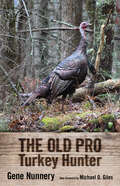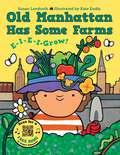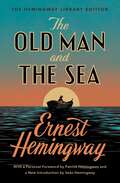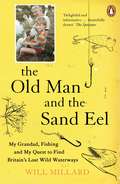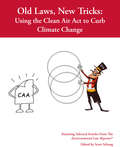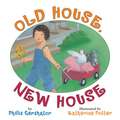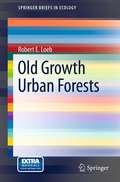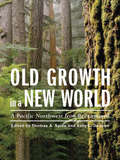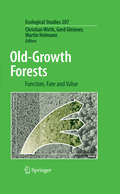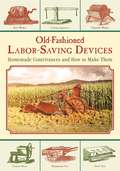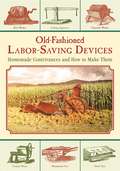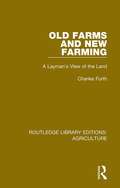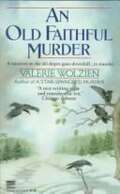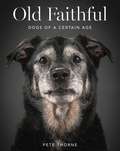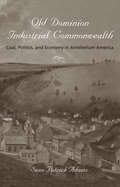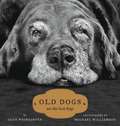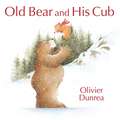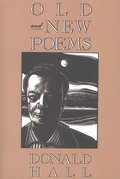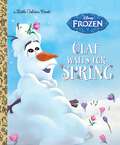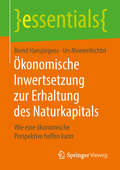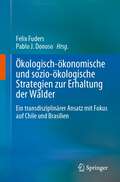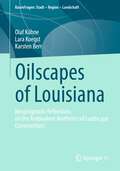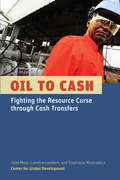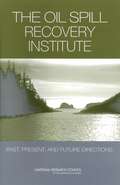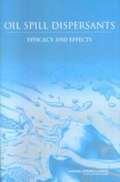- Table View
- List View
The Old Pro Turkey Hunter
by Gene NunneryDuring his life, Gene Nunnery was recognized as a master turkey hunter and an artisan who crafted unique, almost irresistible turkey calls. In The Old Pro Turkey Hunter, the vaunted sportsman shares over fifty years of personal experience in Mississippi and surrounding states, along with the decades-old wisdom of the huntsmen who taught him. Throughout the book, his stories make clear that turkey hunting is more than just killing the bird—it is about matching wits with a wild and savvy adversary. As Nunnery explains, “To me that’s what it’s all about: finding a wise old gobbler who will test your skill as a turkey hunter.” Through his stories, Nunnery reveals that the true reward for successful turkey hunting lies in winning the contest, not necessarily exterminating the foe. Real sportsmen know that every now and then the turkey should and will elude the hunter. As Nunnery looks back on his extensive career, he analyzes vast differences in practice, old and new. The shift, he decides, came during his last twenty years on the hunt, and that difference has only increased in the decades since this book was originally published. Michael O. Giles, Bass Pro staff team member, master turkey hunter, and award-winning outdoors writer and author of Passion of the Wild, writes a new foreword that brings the practice of turkey hunting into the present day. Filled with a tested mixture of common sense and specific examples of how master turkey hunters honor their harvest and heritage, The Old Pro Turkey Hunter is the perfect companion for the novice or the adept.
Old Manhattan Has Some Farms
by Susan LendrothA clever new spin on "Old MacDonald," this fun book explores the popular trend of urban farming. From rooftop farms and gardens on Manhattan high rises to neighborhood gardens in empty lots in Atlanta to hydroponic gardens in Seattle, growing food locally has become an important part of city-dwelling life.Set to the tune of the popular children's song, this bouncy rhyming text will get everyone reading (or singing) out loud. If you're not comfortable singing aloud, download the free recording of the song created by popular children's performer Caspar Babypants (aka Chris Ballew, lead singer and songwriter for the band The Presidents of the United States of America). Six North American cities are highlighted, but included in the back matter are tips and tricks on how to alter the text so you can sing about your own hometown gardens.Back matter also includes more information about the different types of gardens introduced, additional resources, and the sheet music for the song.
The Old Man and the Sea: The Hemingway Library Edition (Hemingway Library Edition)
by Ernest HemingwayErnest Hemingway&’s most beloved and popular novel ever, with millions of copies sold—now featuring early drafts and supplementary material as well as a personal foreword by the only living son of the author, Patrick Hemingway, and an introduction by the author&’s grandson Seán Hemingway.The last novel Ernest Hemingway saw published, The Old Man and the Sea has proved itself to be one of the enduring works of American fiction. It is the story of an old Cuban fisherman, down on his luck, and his supreme ordeal: a relentless, agonizing battle with a giant marlin far out in the Gulf Stream. Using the simple, powerful language of a fable, Hemingway takes the timeless themes of courage in the face of defeat and personal triumph won from loss and transforms them into a magnificent twentieth-century classic. Written in 1952, this hugely successful novel confirmed his power and presence in the literary world and played a large part in his winning the 1954 Nobel Prize for Literature.
The Old Man and the Sand Eel
by Will Millard'A wonderfully fluent account of how the strange magic of water and the beings that inhabit it can enchant and intoxicate' Chris YatesGrowing up on the Cambridgeshire Fens, Will Millard never felt more at home than when he was out with his granddad on the riverbank, whiling away the day catching fish. As he grew older his competitive urge to catch more and bigger fish led him away from that natural connection between him, his grandfather and the rivers of his home. That is, until the fateful day he let a record-breaking sand eel slip through his fingers and he knew that he had lost the magic of those days down by the river, and that something had to change. The Old Man and the Sand Eel is at its heart the story of three generations of men trying to figure out what it is to be a man, a father and a fisherman. It plots Will's scaly stepping stones back to his childhood innocence, when anything was possible and the wild was everywhere.***'[Will Millard] is a master wordsmith and his first book is a joyful testament to that' Isabelle Broom, Heat'[Will Millard] writes with a genuine sense of humility (...) humour and reflection' Kevin Parr, Countryfile 'Delightful and informative (...) beautifully drawn (...)The Old Man and The Sand Eel will be enjoyed by anyone who loves the challenge and mystery of baiting a hook and plopping it into the water' Spectator'This is post-modern nature writing that embraces beauty where it finds it and marvels at nature's tenacity (...) But there's more here than just fish. This is also a book about growing up, about how to retain a connection with those who raised you while forging your own identity - what to keep and what to discard. And it's about men. The strong surges of emotion that both draw them together and keep them apart, and the shared pastimes which recognise that intimacy and meaning aren't always accompanied by words' Olivia Edward, Geographical
Old Law, New Tricks: Using the Clean Air Act to Curb Climate Change
by Robert B. Mckinstry Jr. Brigham Daniels Timothy Profeta Robert A. Wyman Robert D. Brenner Franz Litz Marie Ly Anna Marie Wood Scott H. Segal Institute for Policy Integrity Nathan Richardson Brooks Rainey Pearson Nicholas Bianco Leila B. Azari Richard B. Herzog Arnold W. Reitze Jr. Claudine Schneider Davonne Flanagan Nicholas W. Fels Jonas Monast Charles H. Haake Patricia A. Eberwine Scott Schang Gary S. Guzy Kristin Igusky Meek The National Climate Coalition Timothy J. Mullins James Salzman Natural Resources Defense Council Art Fraas Emily Taylor John C. Dernbach John Doyle Thomas D. Peterson Dallas Burtraw Hannah Polikov Delavan Dickson Michael B. Gerrard Raymond B. Ludwiszewski David M. Driesen M. Rhead Enion Curtis A. Moore Rebecca Gasper Hannah ChangFew if any people think the Clean Air Act is the optimal legislative solution to climate change; but it is a powerful tool that is being used sometimes despite the prevailing political will. To address this reality, this volume calls on the best writing from the most often-cited environmental law journal in the United States, the Environmental Law Reporter®, to explain the possibilities and pitfalls in using this regulatory framework to address greenhouse gases (GHGs) and short-lived climate pollutants. This collection does not have a singular perspective or agenda other than to highlight multiple suggestions about ways in which the Act should or should not be used to address climate change. The Environmental Law Institute and editors of Environmental Law Reporter® do not endorse any approach outlined in these pages but instead present various ideas to educate and spur public debate and discussion.
Old House, New House
by Phillis GershatorIt's summer, and a little girl likes moving into an old country house with a cranberry bog, a bullfrog creek, and farm animals that live down the road. But when fall comes, it's time to pack up and move again--all the way across the country to a new house in a new place with new friends and new adventures.
Old Growth Urban Forests
by Robert E. LoebMillions of urbanites never see primeval forests during their lives except for the old growth forests found in urban parks. Unfortunately, these forests are on the verge of disappearing because arboreal reproduction is lost to human trampling and park administrators and urban foresters do not maintain these "natural" forests. To aid urban foresters and park managers in meeting the challenges, research on old growth forests in urban parks is synthesized in terms of historical ecology to introduce the methods utilized to reveal long-term forest composition changes. The case study of three stands in Fairmount Park, Philadelphia, PA relates pre-chestnut blight tree species densities and post-chestnut blight arboreal changes to fire and visitor trampling. The information gained on how urban old growth forests have developed and changed is used to develop restoration ecology based frameworks to restore species composition and address challenges to forest survival including invasive species.
Old Growth in a New World: A Pacific Northwest Icon Reexamined
by Sally L. Duncan Thomas A. SpiesOld-growth forests represent a lofty ideal as much as an ecosystem--an icon of unspoiled nature, ecological stability, and pristine habitat. These iconic notions have actively altered the way society relates to old-growth forests, catalyzing major changes in policy and management. But how appropriate are those changes and how well do they really serve in reaching conservation goals? Old Growth in a New World untangles the complexities of the old growth concept and the parallel complexity of old-growth policy and management. It brings together more than two dozen contributors--ecologists, economists, sociologists, managers, historians, silviculturists, environmentalists, timber producers, and philosophers--to offer a broad suite of perspectives on changes that have occurred in the valuing and management of old-growth forests in the Pacific Northwest over the past thirty years. The book * introduces the issues and history of old-growth values and conservation in the Pacific Northwest; * explores old growth through the ideas of leading ecologists and social scientists; * addresses the implications for the future management of old-growth forests and considers how evolving science and social knowledge might be used to increase conservation effectiveness. By confronting the complexity of the old-growth concept and associated policy and management challenges, Old Growth in a New World encourages productive discussion on the future of old growth in the Pacific Northwest and offers options for more effective approaches to conserving forest biodiversity.
Old-Growth Forests
by Christian Wirth Martin Heimann Gerd GleixnerMany terms often used to describe old-growth forests imply that these forests are less vigorous, less productive and less stable than younger forests. But research in the last two decades has yielded results that challenge the view of old-growth forests being in decline. Given the importance of forests in battling climate change and the fact that old-growth forests are shrinking at a rate of 0.5% per year, these new results have come not a moment too soon. This book is the first ever to focus on the ecosystem functioning of old-growth forests. It is an exhaustive compendium of information that contains original work conducted by the authors. In addition, it is truly global in scope as it studies boreal forests in Canada, temperate old-growth forests in Europe and the Americas, and global tropical forests. Written in part to affect future policy, this eminently readable book is as useful for the scientist and student as it is for the politician and politically-interested layman.
Old-Fashioned Labor-Saving Devices
by Skyhorse PublishingThe practical, intriguing American devices contained in this handbook come from an era long before milking machines, pesticide sprayers, and industrial hay balers. Designed to speed and simply everything from making your own butter to protecting drain outlets to organizing and storing tools, the easy-to-make mechanisms you'll find here can be just as useful for today's farmer as they were for frontier homesteaders.Discover how to transform odds and ends-scraps of lumber from old building projects, leftover sections of barbed wire, the box spring sitting in the attic-into handy household implements. With the illustrated instructions here, you can make a movable nest for hens, a ribless boat, a contraption to extricate a mired animal, a farm cart with movable racks for larger roads, a wire fence tightener, a fruit picker, a grindstone set and frame, and much more. This book is perfect for the rancher, farmer, craftsman-anyone with a love of the rural life.
Old-Fashioned Labor-Saving Devices: Homemade Contrivances and How to Make Them
by Skyhorse PublishingThe practical, intriguing American devices contained in this handbook come from an era long before milking machines, pesticide sprayers, and industrial hay balers. Designed to speed and simply everything from making your own butter to protecting drain outlets to organizing and storing tools, the easy-to-make mechanisms you’ll find here can be just as useful for today’s farmer as they were for frontier homesteaders.Discover how to transform odds and ends-scraps of lumber from old building projects, leftover sections of barbed wire, the box spring sitting in the attic-into handy household implements. With the illustrated instructions here, you can make a movable nest for hens, a ribless boat, a contraption to extricate a mired animal, a farm cart with movable racks for larger roads, a wire fence tightener, a fruit picker, a grindstone set and frame, and much more. This book is perfect for the rancher, farmer, craftsman-anyone with a love of the rural life.
Old Farms and New Farming: A Layman's View of the Land (Routledge Library Editions: Agriculture #14)
by Charles FurthFirst published in 1975. This title presents a series of vivid insights and images, explaining the problems in the field, the machinery and techniques, science and economics, and what it means to the farm worker. The book depicts and explains the sophisticated techniques with which the farmer tackles the problems of soil and season, within the beautiful and ancient rhythm of lambing and haymaking, pasture and dairy, seed time and harvest. This title will be of great interest to not only students of agriculture, but those interested in the history of farming.
An Old Faithful Murder (Susan Henshaw Mystery #5)
by Valerie WolzienMURDER IS A FAMILY AFFAIR. The Henshaw family vacation to Yellowstone National Park promised two fun-filled weeks of fantastic scenery, great skiing, and sightseeing. Best of all, Susan's two teenagers found buddies in the Ericksen clan, who'd gathered at the lodge for their first family reunion. But there's trouble brewing among the Ericksens. A stuffed dummy dressed like the domineering patriarch is found sprawled by Old Faithful. A practical joke; obviously. But no one is laughing when the real murdered body of George Ericksen is found in the-same spot. When her reputation for solving murder cases in her Connecticut suburb is revealed, Susan is asked to find the killer. A web of twisted emotions and buried family secrets quickly unfolds, and Susan discovers everyone had reason to kill George. But who hated him enough to resort to murder at a world-famous resort? Well over half of the books in the Susan Henshaw Mystery series are ready for you in Bookshare's library with the rest on the way. Susan is the quintessential upper middle class housewife with the latest and greatest in brand name appliances, accessories and clothing to prove it. With the home front well in hand she is always poised and ready when her path intersects with murder to apply her social, domestic and other talents to solving the crimes. Look for: #1 Death at a PTA Luncheon, #2 The Fortieth Birthday Body, #3 We Wish You A Merry Murder, #4 All Hallows' Evil, #6 A Star Spangled Murder, #11 Weddings are Murder, #13 Death At A Discount, #14 An Anniversary To Die For, #15 Death in a Beach Chair and #16 Death in Duplicate.
Old Faithful: Dogs of a Certain Age
by Pete ThorneOld Faithful is a striking and heartrending collection of photographs and stories featuring dogs who are well worn, well loved, and well on in years. The Old Faithful Project started after photographer Pete Thorne snapped photographs for his grandmother's hundredth birthday party. Inspired, he began photographing elderly dogs. What he discovered were faces with more life, more joy, and more wisdom than he could have ever anticipated.After he posted a few photographs, stories and pictures came pouring in from around the globe--people wanted to share tales of their own senior dogs. Thorne met with hundreds of senior dogs and their best friends and human companions. Old Faithful features seventy-five of these dogs and their stories.Each dog has a different background. Some were rescued from pet mills, like seventeen-year-old Chihuahua Sam, who has exceeded his life expectancy by five years and counting. Some needed a forever home after their owners could no longer care for them, like sixteen-year-old toy poodle Grimm, who's had a long list of health problems but remains as unique and lovable as ever. And some have been companions since puppyhood, like ten-year-old rottweiler Brut, who loves his human siblings as if he were their mother. But all of these dogs are beloved, in their own patchy, scruffy, jowly glory.
Old Dominion, Industrial Commonwealth: Coal, Politics, and Economy in Antebellum America (Studies in Early American Economy and Society from the Library Company of Philadelphia)
by Sean Patrick AdamsSelected by Choice Magazine as an Outstanding Academic TitleIn 1796, famed engineer and architect Benjamin Henry Latrobe toured the coal fields outside Richmond, Virginia, declaring enthusiastically, "Such a mine of Wealth exists, I believe, nowhere else!" With its abundant and accessible deposits, growing industries, and network of rivers and ports, Virginia stood poised to serve as the center of the young nation's coal trade. By the middle of the nineteenth century, however, Virginia's leadership in the American coal industry had completely unraveled while Pennsylvania, at first slow to exploit its vast reserves of anthracite and bituminous coal, had become the country's leading producer.Sean Patrick Adams compares the political economies of coal in Virginia and Pennsylvania from the late eighteenth century through the Civil War, examining the divergent paths these two states took in developing their ample coal reserves during a critical period of American industrialization. In both cases, Adams finds, state economic policies played a major role. Virginia's failure to exploit the rich coal fields in the western part of the state can be traced to the legislature's overriding concern to protect and promote the interests of the agrarian, slaveholding elite of eastern Virginia. Pennsylvania's more factious legislature enthusiastically embraced a policy of economic growth that resulted in the construction of an extensive transportation network, a statewide geological survey, and support for private investment in its coal fields.Using coal as a barometer of economic change, Old Dominion, Industrial Commonwealth addresses longstanding questions about North-South economic divergence and the role of state government in American industrial development, providing new insights for both political and economic historians of nineteenth-century America.
Old Dogs
by Michael S. Williamson Gene WeingartenAnyone who has ever loved an old dog will love Old Dogs. In this collection of profiles and photographs, Weingarten and Williamson document the unique appeal of man's best friend in his or her last, and best, years. This book is a tribute to every dog who has made it to that time of life when the hearing and eyesight begin to go, when the step becomes uncertain, but when other, richer traits ripen and coalesce. It is when a dog attains a special sort of dignity and a charm all his own. If you've known a favorite old dog, you'll find him or her on these pages. Your dog might go by a different name and have a different shape, but you'll recognize him or her by the look in an eye or the contours of a life story. There is the dog who thinks he is a house cat; the herder, the fetcher, the punk and the peacock, the escape artist, the demolition artist, the patrician, the lovable lout, the amiable dope, the laughable clown, the schemer, the singer, the daredevil, the diplomat, the politician, the gourmand, and the thief. Plus, as a special bonus, you will find the first Latvian elkhounds ever photographed. Old Dogs is a glorious gift book and a fitting tribute to that one dog you can't ever forget.
Old Bear and His Cub (Little Cub)
by Olivier DunreaFrom the creator of the Gossie and Gertie books comes a playful and charming twist on the relationship between children and the adults who care for them.Old Bear loves Little Cub with all his heart. He makes sure that Little Cub eats all his porridge, takes a nap during their snowy walk, and wraps his red scarf tightly around his ears. Little Cub doesn't want to be told what to do, but he always listens to Old Bear because he knows that Old Bear loves him so. But when Old Bear catches a cold, it's Little Cub who knows just what to do to make Old Bear feel better. This winning story shows just how much Old Bears and Little Cubs love one another--with all their hearts.
Old and New Poems: Donald Hall
by Donald HallThis collection drawn from more than forty years of the poet’s work is “a superb introduction to newcomers and a sumptuous offering to familiars” (Publishers Weekly).Former US Poet Laureate Donald Hall has been celebrated with numerous awards, including the National Book Critics Circle Award and the National Medal of the Arts.This volume collects some of Hall’s finest short poetry written between 1947 and 1990. Here are poems of landscape and love, of dedication and prophecy.“Our delight is in following an exceptional poet's growth and depth as he emerges with a richly playful but consummately serious voice.” —Publishers Weekly
Olaf Waits for Spring (Little Golden Book)
by Victoria SaxonThis Little Golden Book features an original story about springtime starring Olaf, Anna, Elsa, and Kristoff from Disney's Frozen!Olaf already knows he loves summer, but what about spring? Anna, Elsa, and Kristoff get the snowman excited with tales of blooming flowers, sailing trips, and baby animals. Children ages 2 to 5 will love this Little Golden Book, which features the beloved characters from Disney Frozen. It's perfect for Easter time, springtime, or anytime!Disney Frozen is the #1 animated film of all time, featuring a powerful story, strong ensemble cast, a pair of relatable sisters, magical environments, and unforgettable music.
Ökonomische Inwertsetzung zur Erhaltung des Naturkapitals: Wie eine ökonomische Perspektive helfen kann (essentials)
by Bernd Hansjürgens Urs MoesenfechtelIn diesem essential beschreiben Bernd Hansjürgens und Urs Moesenfechtel die Dringlichkeit eines Perspektivenwechsels bei unserem Umgang mit der Natur. Sie schlagen dazu eine ökonomische Inwertsetzung von Ökosystemleistungen vor und zeigen auf, welche Handlungsmöglichkeiten dieser Ansatz dem Naturschutz eröffnet.
Ökologisch-ökonomische und sozio-ökologische Strategien zur Erhaltung der Wälder: Ein transdisziplinärer Ansatz mit Fokus auf Chile und Brasilien
by Felix Fuders Pablo J. DonosoIn diesem Buch werden Strategien zur Verbesserung der Widerstandsfähigkeit und des Schutzes der gemäßigten Wälder in Südamerika vorgeschlagen, damit diese Wälder auf nachhaltige Weise Ökosystemleistungen erbringen können. Als solches trägt es zum Entwurf eines widerstandsfähigen Mensch-Wald-Modells bei, das die Multikulturalität lokaler Gemeinschaften berücksichtigt und in vielen Fällen Aspekte der ökologischen Ökonomie, der Entwicklungsökonomie und der territorialen Entwicklungsplanung einbezieht, die mit indigenen Völkern oder „First Nations“ zu tun haben. Darüber hinaus werden Vorschläge für öffentliche und territoriale Politiken unterbreitet, die den Erhaltungszustand der einheimischen Wälder und Waldökosysteme verbessern, und zwar auf der Grundlage einer kritischen Analyse der wirtschaftlichen Faktoren, die zur Degradierung der Waldökosysteme im heutigen Südamerika führen.Dieses Buch wurde von Mitgliedern des Transdisziplinären Forschungszentrums für soziale und ökologische Strategien zur nachhaltigen Waldbewirtschaftung in Südamerika an der Universidad Austral de Chile konzipiert. Es enthält Beiträge von renommierten Forschern aus der ganzen Welt, die die Bereiche Wirtschaft, Ökologie, Biologie, Anthropologie, Soziologie und Statistik miteinander verbinden. Es handelt sich jedoch nicht einfach um eine Sammlung von Arbeiten, die von Autoren aus verschiedenen Disziplinen verfasst wurden. Vielmehr erhebt jedes Kapitel den Anspruch, in sich selbst transdisziplinär zu sein. Dieser Ansatz macht das Buch zu einem einzigartigen Beitrag zur Verbesserung sozialer, betriebswirtschaftlicher und politischer Ansätze in der Waldbewirtschaftung, die dazu beitragen, die Ökosystemleistungen des Waldes zu schützen und nachhaltiger zu gestalten. Dies wiederum kommt den lokalen Gemeinschaften und der Gesellschaft als Ganzes zugute, indem die negativen externen Effekte der Forstwirtschaft verringert und die Zukunftschancen verbessert werden.
Oilscapes of Louisiana: Neopragmatic Reflections on the Ambivalent Aesthetics of Landscape Constructions (RaumFragen: Stadt – Region – Landschaft)
by Olaf Kühne Lara Koegst Karsten BerrOilscapes are to be understood as an aestheticized synthesis of objects of extraction, distribution, processing, and consumption of petroleum and petroleum-derived products. Based on the concept of neopragmatic landscape research, this book addresses questions of the social construction of the relationship between the petrochemical industry and the landscape, as well as individual interpretations and evaluations in this regard. The particular focus is on exploring the possibilities and limits of aesthetic experience of oilscapes as well as the categorizations, interpretations, and evaluations of these aesthetic outcomes. In recourse to the neopragmatic tradition, to the thinking of Richard Rorty, the engagement with ‘sensory induced cognition' is carried out from the stance of irony, directed in particular at the discourse community possessing 'expert special knowledge', with a special focus on methods of representation that are innovative in the context of spatial science. The study area for assessing this approach is Louisiana (United States), which – being spatially quite diverse – has been intensively shaped for more than a century by the activities of the petrochemical industry, as well as its unintended health and ecological side effects.
Oil to Cash: Fighting the Resource Curse Through Cash Transfers
by Caroline Lambert Todd Moss Stephanie MajerowiczWhat should a country do if it suddenly discovers oil and gas? How should it spend the subsequent cash windfall? How can it protect against corruption? How can citizens truly benefit from national wealth? With many of the world's poorest and most fragile states suddenly joining the ranks of oil and gas producers, these are pressing policy questions. Oil to Cash explores one option that may help avoid the so-called resource curse: just give the money directly to citizens. A universal, transparent, and regular cash transfer would not only provide a concrete benefit to regular people, but would also create powerful incentives for citizens to hold their government accountable. Oil to Cash details how and where this idea could work and how policymakers can learn from the experiences with cash transfers in places like Mexico, Mongolia, and Alaska.
The Oil Spill Recovery Institute: Past, Present, And Future Directions
by Committee to Review the Oil Spill Recovery Institute's Research ProgramAs a result of the 1989 Exxon Valdez Oil Spill in Prince William Sound, Congress passed the Oil Pollution Act of 1990 (OPA 90), and within that legislation, the Oil Spill Recovery Institute (OSRI) was born. This book assesses the strength and weaknesses of this research program, with empahsis on whether the activities supported to date address the OSRI mission, whether the processes used are sound, and whether the research and technology development projects are of high quality.
Oil Spill Dispersants: Efficacy and Effects
by National Research Council of the National AcademiesApproximately 3 million gallons of oil or refined petroleum products are spilled into U.S. waters every year. Oil dispersants (chemical agents such as surfactants, solvents, and other compounds) are used to reduce the effect of oil spills by changing the chemical and physical properties of the oil. By enhancing the amount of oil that physically mixes into the water, dispersants can reduce the potential that a surface slick will contaminate shoreline habitats. Although called for in the Oil Pollution Act of 1990 as a tool for minimizing the impact of oil spills, the use of chemical dispersants has long been controversial. This book reviews the adequacy of existing information and ongoing research regarding the effectiveness of dispersants as an oil spill response technique, as well as the effect of dispersed oil on marine and coastal ecosystems. Oil Spill Dispersants also includes recommended steps for policy makers faced with making hard choices regarding the use of dispersants as part of spill contingency planning efforts or during actual spills.
